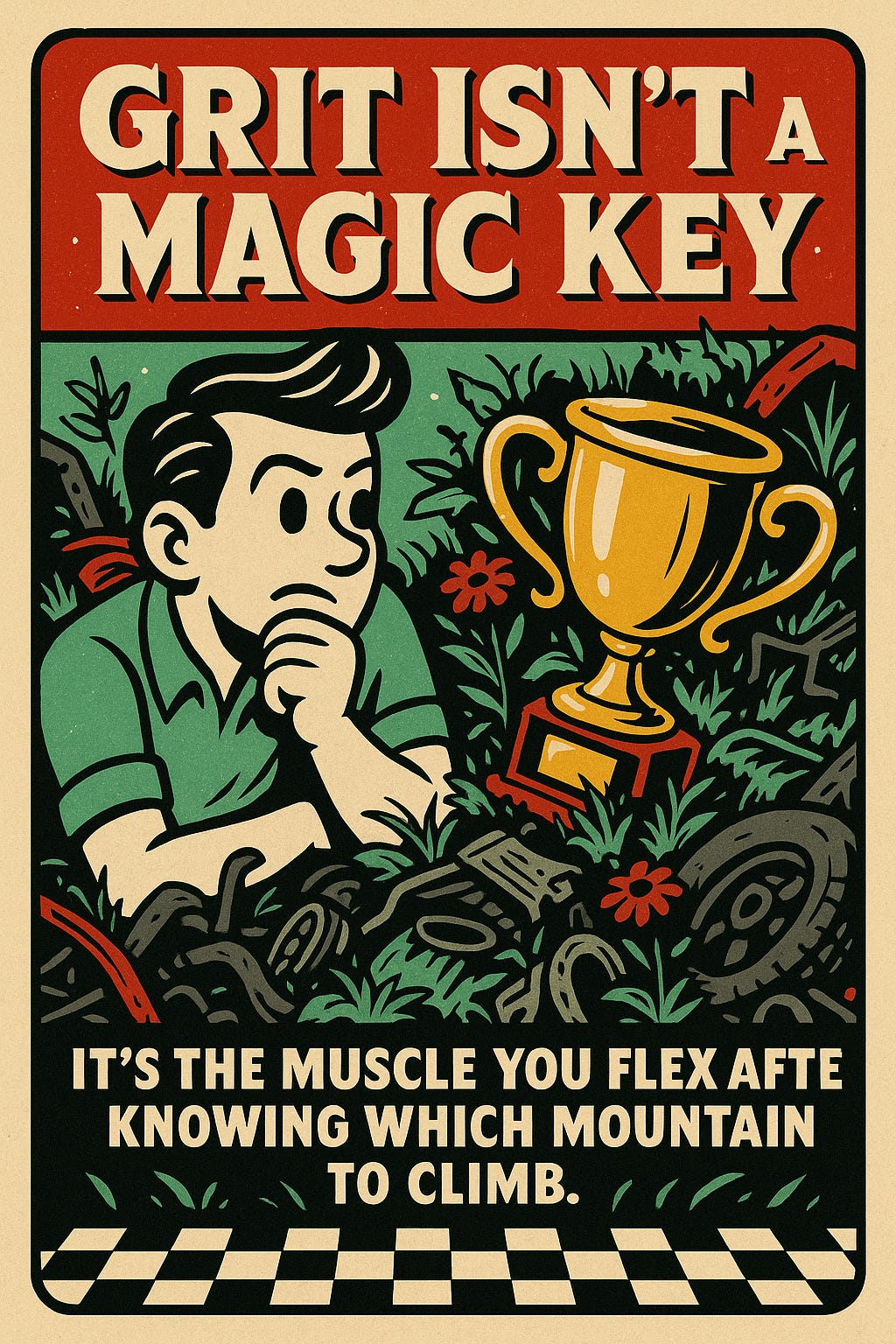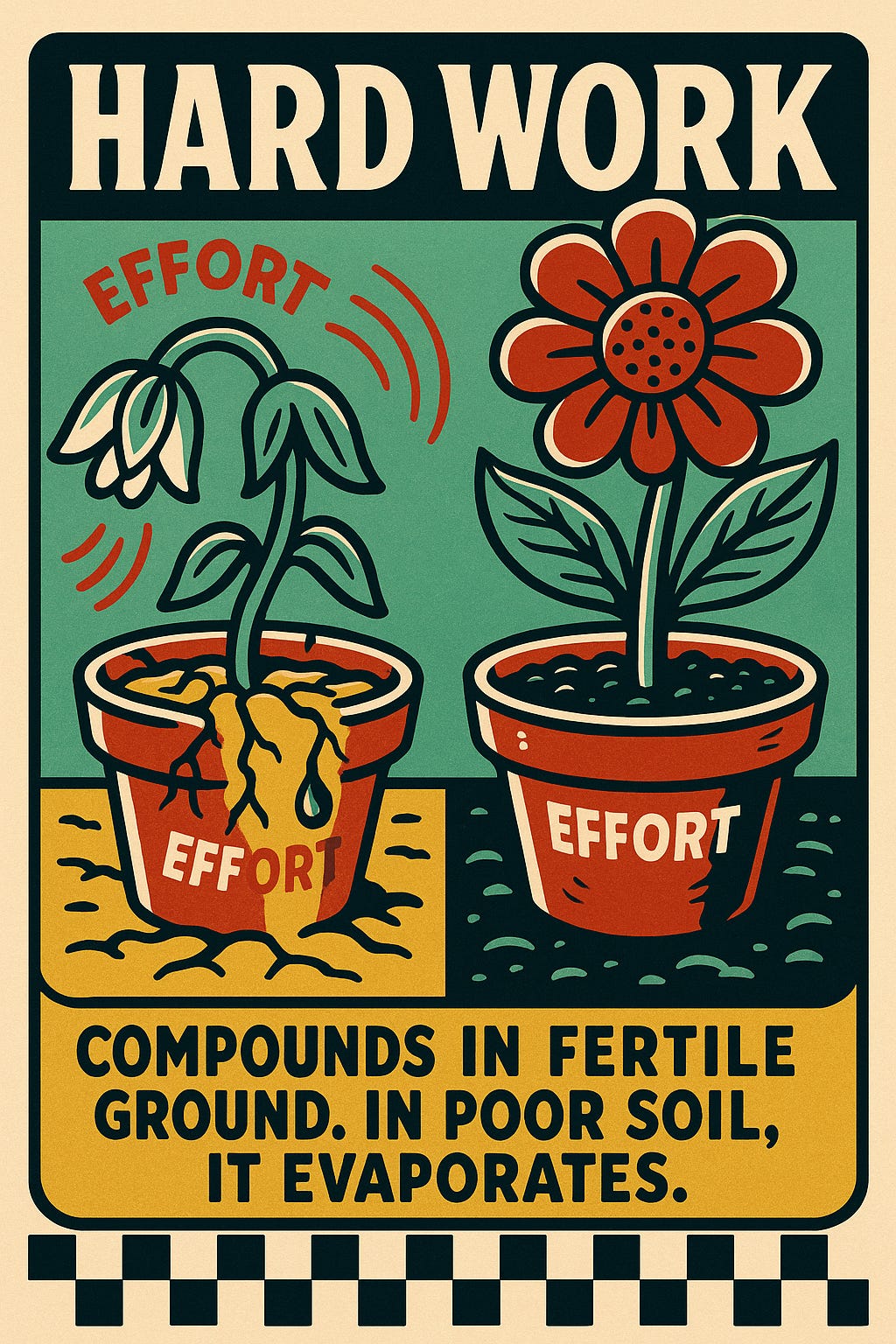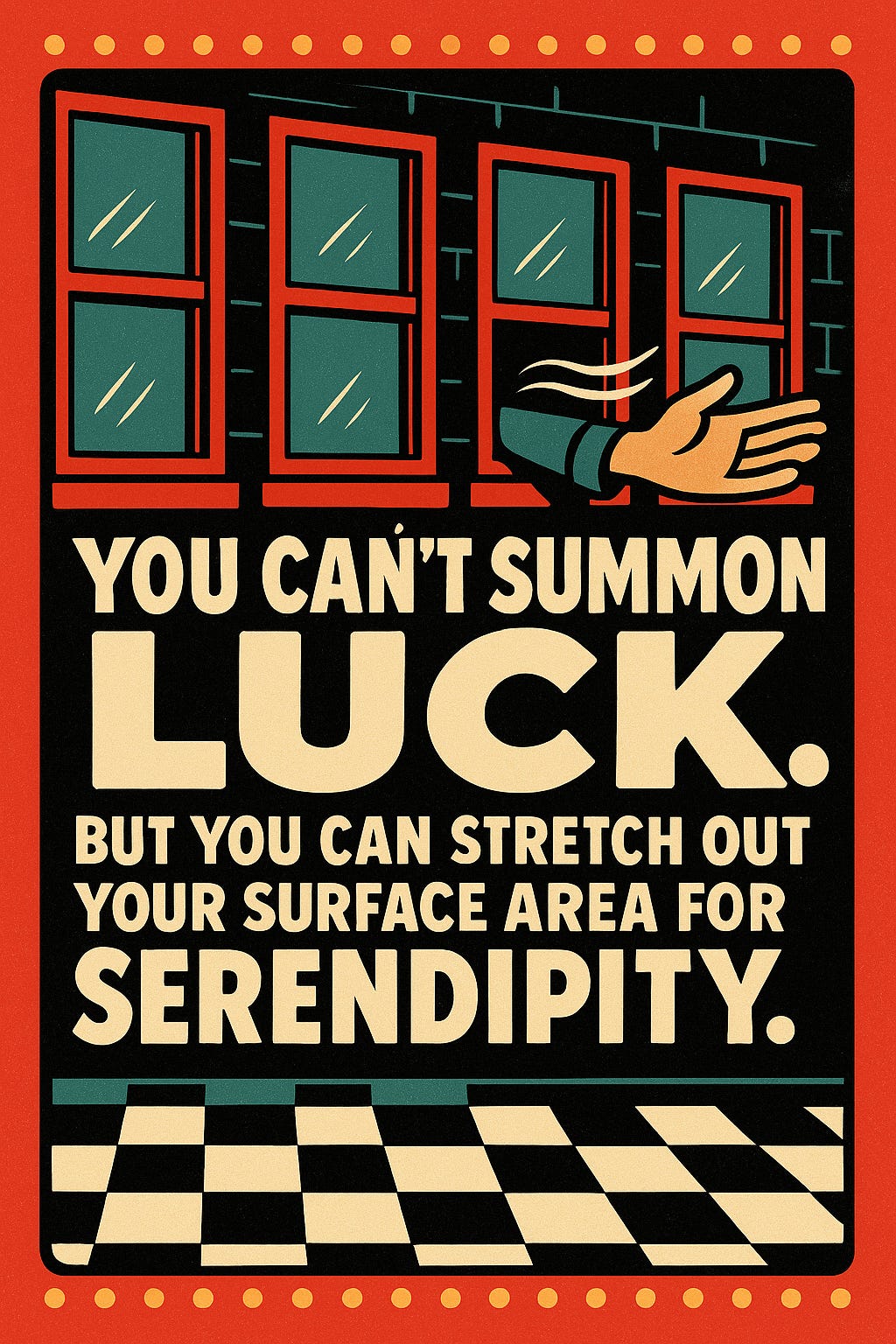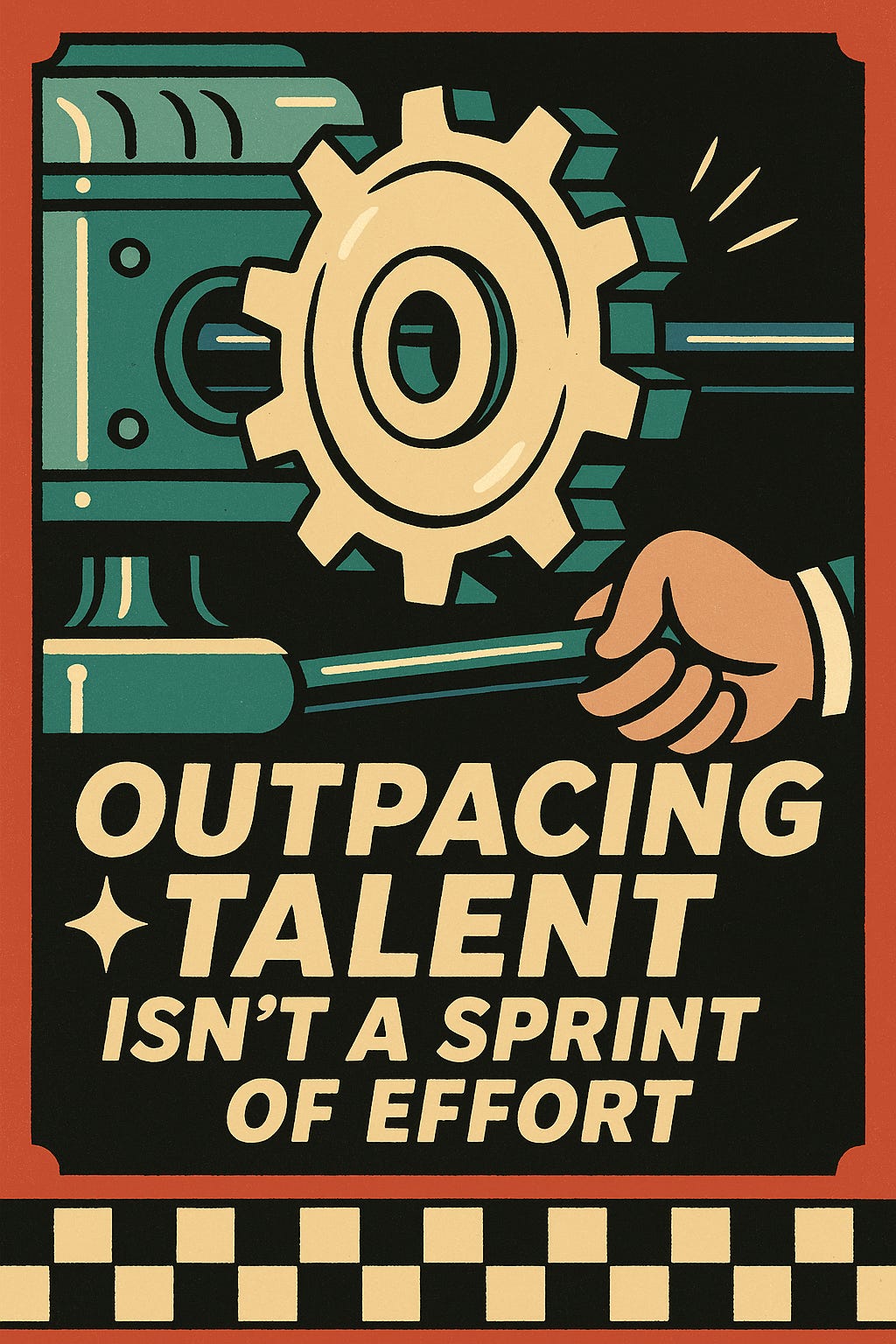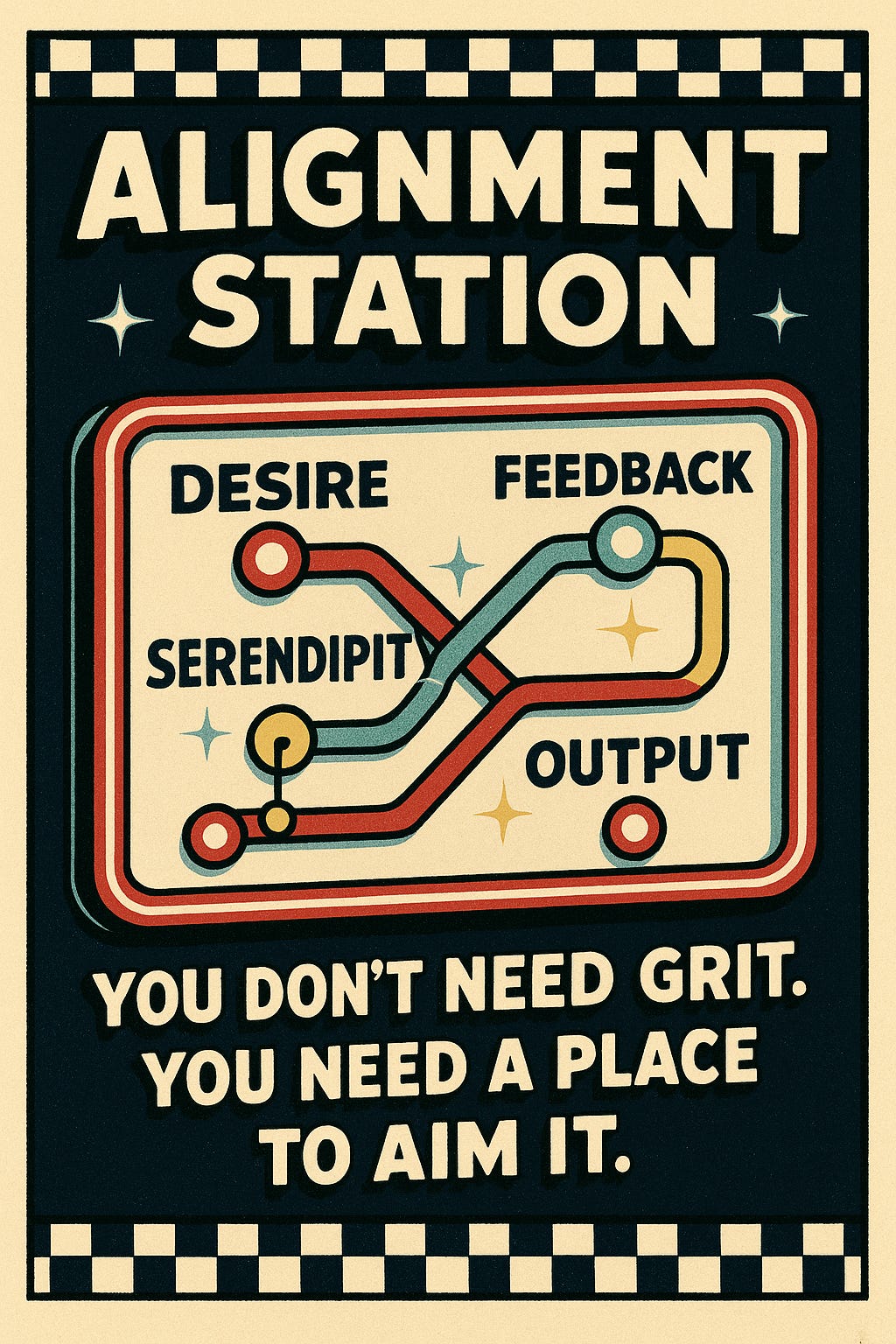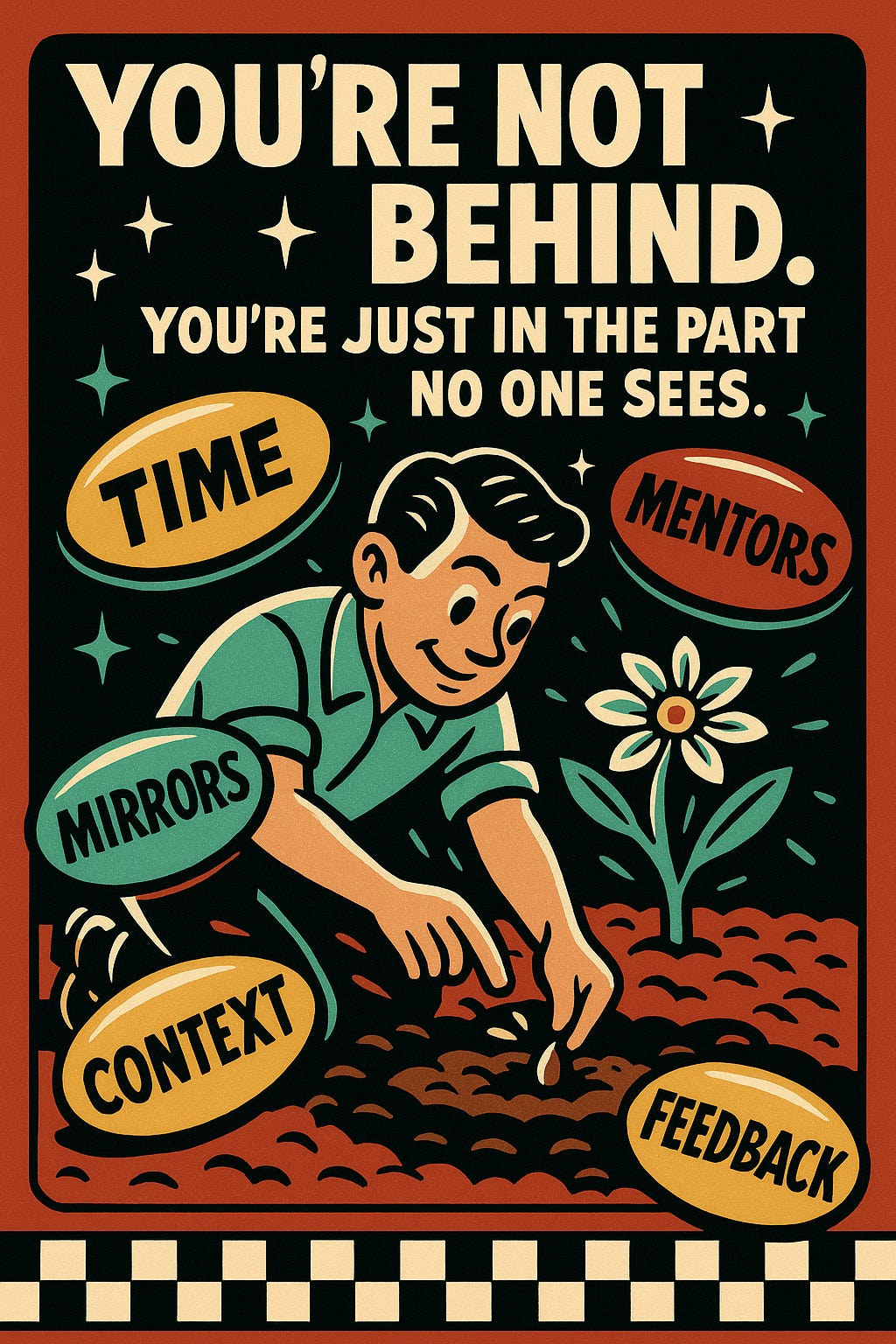Sunday Longform: Grit Isn’t Rare. Alignment Is.
Hard work is real. But it only compounds when it meets the right mirrors, momentum, and meaning.
The Premise
I used to think I was bad at working hard. Or lazy. Or just not built like the high-performers I watched on the internet; sweaty, confident, caffeinated, crossing out to-do lists with violent joy. I thought maybe I didn’t have the stomach for the grind. That I liked sleep too much. That maybe I didn’t want it badly enough.
But that wasn’t true.
I was working hard. I was burning out. I just wasn’t getting anywhere.
That’s the thing about grit. We romanticize it. We make it look like a moral quality, a thing you either have or don’t. But most of us aren’t suffering from a grit deficiency. We’re suffering from an alignment crisis. Our effort is real. Our exhaustion is real. What’s broken is the setup. No map. No margin. No meaningful feedback. We’re sprinting inside mazes. Grit doesn’t save you from that. It just makes the loops longer.
Angela Duckworth gave us grit as a gift. A counter to the idea that you have to be a prodigy or a genius to succeed. That talent is fate. And that’s still true. Grit does matter. But grit without scaffolding is just effort in the dark. In startup circles, we talk about surface area for serendipity, this idea that luck can’t be controlled, but it can be engineered. You show up more. You publish more. You walk into the rooms where lightning tends to strike.
Same goes for grit.
It doesn’t guarantee outcomes. But when paired with the right environment (and feedback, visibility, community) it becomes exponential. It becomes direction. It becomes fuel.
And when it isn’t paired with those things? It curdles. It starts to look like self-blame. Like burnout. Like resentment. Like confusing pain with progress.
This essay is about what it takes to make grit work. Not in theory, but in practice. Not as some grand ideal, but as a real, repeatable engine of progress. I’m going to tell you why most people are grinding themselves into the ground and still not seeing results. I’m going to tell you how to flip the equation. I’m going to show you what makes the difference between burnout and breakthrough. And I’m going to show you how to create the kind of conditions, mentally, structurally, socially, where your effort actually has a place to land.
Because grit is not rare.
What’s rare is knowing where to point it. What’s rare is being in the right game, with the right people, at the right time. What’s rare is infrastructure.
And once you see that clearly, everything starts to change.
The Grit Myth (And What It Never Promised)
We turned grit into a gospel. Maybe because it’s comforting. Maybe because it feels fair. The idea that if you just care enough, work hard enough, stay focused long enough, you’ll get there. You’ll earn it. That effort is always rewarded.
But that was never the full promise.
Angela Duckworth didn’t say grit was everything. She said it counts. That over long periods of time, in high-skill domains, deliberate, directed effort outpaces raw talent. She said the long game matters. She said consistency matters. She said obsession with feedback, with craft, and with challenge is more predictive than IQ. She gave us a framework. We turned it into a slogan.
Because slogans are easy.
“Just work harder.”
“Fall down seven times, get up eight.”
“No excuses.”
These phrases sound like wisdom. But they leave too much out. They don’t account for structure, or access, or strategy. They don’t account for being on the wrong ladder. They don’t tell you what to do when you’re working your ass off and still not getting seen.
The myth of grit is not that it’s wrong. It’s that we expect it to save us. That we use it to plug the gaps where systems fail. That we ask people to endure what they shouldn’t have to endure and when they burn out, we say they didn’t want it badly enough.
But grit doesn’t compensate for a lack of oxygen. It doesn’t make up for environments that are silent, isolating, or opaque. It’s a multiplier, not a generator. You still need inputs. You still need signals. You still need direction.
Duckworth herself has said it: grit is domain-specific. It only kicks in when people care. When they believe their effort is meaningful. When there’s a visible path between what they’re doing now and who they want to become. Otherwise, it’s not perseverance. It’s just pain.
And look, I know what it’s like to be stuck in the in-between. To believe you’re working hard, but not the right kind of hard. To hear “grind harder” and feel both seen and unseen by it. Because yeah, you could work more. You could sacrifice more. But to what end? Toward what horizon?
That’s where this gets dangerous. Because when grit becomes the only answer, it becomes a tool of self-blame. A way to turn every failure into a character flaw. And that’s not just cruel, it’s misleading.
What matters isn’t whether you have grit. What matters is where you apply it. How you shape it. Whether it’s part of a system that gives it room to do its job.
You can’t pedal your way out of a broken vehicle. You need alignment. You need leverage. You need the road.
And we’ll get there. But first, we need to break the spell. The myth. The performance of grit as salvation. It’s not the whole story. It was never supposed to be.
Environment Is the Engine
You know what no one tells you about effort? It only works when it’s given the right conditions.
Effort without feedback is a scream into the void.
Effort without visibility is a one-woman show in a locked room.
And effort without community is the quickest route to heartbreak.
Because even the hardest-working person can’t build momentum in a vacuum.
Think about it like this: grit is the fuel. But the engine, the thing that actually moves you forward, is environment.
And I don’t just mean your physical setting (though that matters). I mean your access to context, to calibration, to correction. Do you know what good looks like? Do you have people to compare notes with? Do you get signals when you're off-course? That’s what environment does. It sharpens you. It situates you. It shows you what your work means to someone else.
Let’s take a young coder in a remote tier-3 town. They could be brilliant. They could be building something astonishing. But without exposure to real users, mentors, or the pulse of the ecosystem, their skill risks becoming ornamental. Misapplied. Missed entirely. Put that same coder in a startup house in Indiranagar, Bangalore? Suddenly there’s a Slack group for founders, a product manager giving notes, a demo day on the calendar. That shift isn’t about effort. It’s about placement.
This is what people miss when they glorify grind: effort compounds in context. That’s why two people with the same skills and ambition can end up miles apart. One gets seen, one doesn’t. One gets feedback, one gets ignored. One gets better, one gets bitter. It’s not about who wanted it more. It’s about who had the right scaffolding.
That scaffolding can look like many things. A peer group that actually gives a damn. A boss who takes time to edit your drafts. A college that funds your prototypes. A city where your niche isn’t seen as weird, but as wanted. And once that context clicks into place, something wild happens: your grit starts working. The flywheel turns. The hours start paying off.
Without it? You’re like a plant trying to grow without sunlight. You can still strain upwards. You might even bloom. But it’ll take twice the energy for half the result.
The hard truth: Most people don’t fail because they’re lazy. They fail because they’re misaligned. And when we ignore that, we build systems that punish the wrong things. We tell people to “hustle harder” instead of asking, “Where is your hustle actually landing?”
Effort doesn’t live in a vacuum. It lives in loops: loops of feedback, encouragement, iteration, and trust. The people we call “gritty” often aren’t just resilient. They’re resourced. They’re surrounded. And that’s what lets them keep going when others can’t.
You can pour water into the wrong funnel forever and still stay thirsty.
So the next time you feel stuck, don’t just ask, “Am I trying hard enough?” Ask, “Is this the right game board?” Because sometimes, grit just needs a new place to grow.
Mimetic Desire as a Catalyst
We like to believe our ambition is self-made. That we want what we want because we chose it. That our dreams are some pure expression of selfhood. But, yeah. No. That’s not how it works.
René Girard had a theory: we don’t just imitate actions. We imitate desires. That is, we learn what’s worth wanting by watching what other people want. Desire doesn’t start in a vacuum. It’s mirrored. It’s contagious. It’s copied.
And once you see that, it changes everything.
You start realizing your goals weren’t born in a vacuum. You wanted to write a novel because your classmate got published. You wanted to be a founder because your coworker got funded. You wanted to win because someone else looked like winning. That doesn’t make your ambition fake. It makes it human.
But here’s the rub: mimetic desire is only as helpful as the models you have access to.
If you’re surrounded by people chasing excellence in something real (shipping projects, solving problems, pushing boundaries) you begin to imitate process. You absorb the grind. You fall in love with how they work. You want the doing, not just the trophy. But if you’re surrounded by posturing and performative success—think: LinkedIn hustle bros, fake founders, people faking traction—you start chasing outcomes. You want the optics. The applause. The aesthetic.
And that’s dangerous. Because when you imitate someone’s outcome without imitating their process, you set yourself up for a heartbreak you can’t explain. You do all the “right” things, but none of it sticks. You start to think there’s something wrong with you.
What’s wrong is the mirror.
Great environments don’t just give you support. They give you better models. People who aren’t just winning, but winning in ways you respect. The right kind of envy is clarifying. You watch someone build with love, and you think, I want that kind of life. Not just the job title. Not just the press.
Desire is social. So if your circle doesn’t value your kind of ambition, it won’t feel real. You’ll gaslight yourself out of it. Or worse, you’ll try to pursue it in secret, and nothing sustainable grows in secrecy.
This is why being in the right room changes everything. It doesn’t just give you feedback or access. It recalibrates your wants. It puts you in proximity to people whose passion is honest, not performative. And that rubs off on you. You start chasing things for the right reasons, not just because they look good on a slide deck, but because they make you feel alive.
So yes, grit matters. But mimetic desire decides where you aim it. Who you let influence you is not a soft variable. It’s the spark that lights the whole matchbox.
How to Use Mimetic Desire Well
Curate your inputs like your life depends on it (because it does). You become what you scroll. If your feed is full of hollow flexes and startup theatre, you will slowly start wanting empty things. Unfollow. Mute. Subscribe to the people who are actually building. Follow people who talk about how they work, not just what they’ve won. If their stuff makes you feel small or confused without teaching you anything, it’s not inspiration, it’s noise.
Create a ‘role model audit.’ Once a month, write down who you’ve been admiring lately and why. Are you copying someone’s process or just craving their lifestyle? Are you trying to be them, or be near the version of yourself they unlock? If you don’t like the answers, change the mirror.
Build a ‘process pinterest’ folder. Not moodboards of dream houses. Not Instagram saves of other people’s outfits. I mean: saved interviews, notes, videos, devlogs, email threads, internal decks, anything that documents someone’s thinking process. Especially from people 2–5 years ahead of you. Study how they do, not what they have.
Make a 1:Many learning loop. Instead of DMing someone to “pick their brain,” study the patterns of ten people you admire. Put them in a spreadsheet. Map what their paths looked like. What jobs they took. What books they cite. What problems they solved early. Don’t just try to be them. Reverse-engineer the kind of environments that made them.
Get in rooms where people care about what you care about. This isn’t metaphorical. I mean physically or digitally. Join a Slack group. Volunteer at a niche conference. Comment on forums. Attend the boring workshop with the good Q&A. Passion is contagious but you need to be close enough to catch it.
Ask better questions when you admire someone. Not “How did you get successful?” but “What was hard that you didn’t expect?” or “What did your week look like when things started working?” This gives you process, not performance. It makes the thing feel doable.
Think of this section as the emotional calibration. Grit without alignment is noise. And alignment starts with deciding who gets to whisper into your brain.
Here’s How to Audit Your Desire Map
We like to think we want what we want because we’re rational. Independent. Clear-headed. But most of the time? Our wants are secondhand. We’re absorbing other people’s ambitions and mistaking them for our own.
That’s why you need a desire audit. Not once. Regularly.
Here’s how to do it:
Step 1: Name three people you can’t stop watching right now. This could be admiration or obsession. Could be a peer, a founder, a public figure, a Twitter account.
What parts of their life do you find compelling?
What emotions come up when you see their work? (Jealousy? Hunger? Curiosity? Inadequacy?)
What specific behaviours or traits are you mimicking, maybe without even realizing?
Step 2: Trace the shape of your current ambition. Write down:
What are you trying to do?
Why do you think it matters?
Where did this desire come from?
Now underline anything that feels vague, borrowed, or performative. Ask yourself: If no one saw me succeed at this, would I still want it?
Step 3: Swap outcome envy for process envy. Here’s a cheat code: if you find someone you’re jealous of, don’t chase their outcome. Study their process.
What skills do they have that you could realistically build?
What systems are helping them stay consistent?
What environments are they in that allow them to thrive?
Use jealousy as a flashlight, not a flame.
Step 4: Rebuild with alignment. Take one of your current goals. Now rewrite it using this sentence: "I want to be the kind of person who…"
Examples:
“I want to be the kind of person who ships something weekly.”
“I want to be the kind of person who asks better questions.”
“I want to be the kind of person who people call when something’s on fire.”
This reorients you around identity and direction, not validation.
Step 5: Gut-check your mirrors. Finally, audit your inputs.
Are the people you follow helping you think clearer or just making you feel behind?
Are they teaching you how to build or just perform success?
Be ruthless. Mute. Unfollow. Unsubscribe. Replace them with people who teach you how to try better, not just look better.
This map isn’t perfect. It’ll need re-drawing every season. But even asking these questions? That’s a rebellion against lazy imitation.
That’s when grit becomes power.
Serendipity Isn’t Random. It’s a System
Some people walk into rooms and it feels like the universe rearranged itself to hand them a mic. They meet the right person at the right time. They get “discovered.” They fall into opportunities they “weren’t even trying for.” We chalk it up to luck.
But most of the time? It wasn’t luck. It was surface area.
The honest truth is, serendipity is not a gift, it’s a setup. The people who get lucky the most aren’t always the most talented, or the most charming, or even the most deserving. They’re just playing a better odds game. They’re in the right rooms, at the right frequency, doing the kind of work that’s easy to bump into.
Serendipity is a system. It’s where you go, how often you show up, how visible your effort is, and whether you’ve built any scaffolding for randomness to land.
This doesn’t mean becoming a LinkedIn content bro. It doesn’t mean schmoozing your way through startup events you hate. It means understanding that nothing finds you if it can’t see you. You have to stick your hand out the window. You have to let the world notice what you’re working on, even when it’s early, even when it’s rough, even when no one asks.
The first time someone shared my Substack, it wasn’t because it was the best thing they’d ever read. It was because I’d been putting out one decent essay after another until someone who cared happened to be looking. That’s it. That’s how “breaks” happen.
You can’t control timing. But you can control exposure.
You can’t force lightning. But you can hang out where the sky is open.
You can’t predict who’ll read your post, or try your tool, or talk about you in a room you’re not in. But you can make sure there’s something out there for them to find.
How to Build a System for Serendipity
1. Publish your work before it’s perfect.
Don’t wait for readiness. Start a blog. Post a build thread. Share drafts with friends. Put prototypes on GitHub. Upload the talk you gave. People can’t help you if they don’t know what you’re doing. Imperfect visibility beats polished obscurity.
2. Increase your collision points.
Join events that feel slightly out of your depth. Say yes to panels and podcasts even if you feel underqualified. Post in niche groups. Ask questions at Q&As. Every point of interaction is another node in your luck network.
3. Build in public, but with intent.
Not everything has to be performative. Share updates not to impress, but to signal momentum. Show the thinking, the failures, the roadblocks. That’s how you draw in collaborators, mentors, future teammates. Vulnerability is a magnet when it’s paired with movement.
4. Create a recurring output ritual.
Weekly newsletters, monthly demos, quarterly project reviews. Systems build signal. The more consistent your output, the easier it is for people to track your trajectory and want to jump in.
5. Ask for specific help, publicly.
“I’m looking for a beta tester for a new journaling tool.”
“I need an intro to someone in climate VC.”
“I want feedback on this landing page.”
Make it direct, make it doable. You’d be shocked how many people will step up when you give them a small, clear ask.
6. Keep your door open. Literally.
That one boring co-working space visit. That founder dinner you almost skipped. That “meh” Twitter DM from someone curious. Answer it. Show up. Follow up. Most people miss their shot because it didn’t look like the opportunity they imagined.
We’re not owed magic. But we can manufacture the conditions where it’s more likely to strike.
And if you’ve ever thought, “nothing ever happens to me,” ask yourself: where could it even land?
Make your life bumpable. Then watch what starts to happen.
Grit, Alignment, and the Real Equation
Grit is not the goal. It’s a lever. And levers don’t work without fulcrums. You don’t just pull harder. You place better. You position differently. You change the angle, the terrain, the tension. That’s when effort becomes impact.
This is the part I wish someone had told me sooner. That doing your best in the wrong environment isn’t noble. It’s tragic. That you can be disciplined and focused and resilient, and still be invisible. That all the traits we praise mean nothing if they’re trapped in a context that can’t receive them.
So let’s name the real equation:
Grit × Alignment = Progress
Not grit alone. Not talent alone. Not vibes, network, timing, hustle, or vision alone.
Alignment is what multiplies effort. And alignment comes down to three things:
Internal resonance: Does this work actually matter to you, or are you chasing something mimetically? Are you working for the prize, or the process?
Environmental match: Are you in a place that recognizes and rewards the kind of value you create? Or are you constantly trying to prove your worth to people who can’t even see it?
Strategic leverage: Are you doing high-slope work, work that gets easier the better you get, or are you stuck in flat loops with no compounding?
If you get these three right, your effort starts compounding. It becomes satisfying. Sustainable. Even joyful. You’re not constantly swimming upstream.
But if even one is off? It drags everything down. Misaligned effort doesn’t just stall, it corrodes. You start to doubt yourself. You start to think you’re the problem. And maybe you burn out, or maybe you keep pushing, but either way, you stop growing.
This is why advice like “just keep going” is so dangerous. Because there’s no just. Persistence is only noble when it’s directionally sound. You don’t praise someone for running in circles. You praise them for finding their way through.
And the truth is: grit isn’t infinite. You will run out of fuel if there’s no feedback, no visibility, no meaning. The goal isn’t to be endlessly resilient. The goal is to not need to be.
We treat grit like the climax of the story. But really, it’s the middle. The long, unglamorous middle. The part where the main character keeps showing up, but only because something inside them clicks with something around them. That’s what makes it work. That’s what makes it last.
So no, you’re not broken if you’re tired. You’re not lazy if your current context isn’t rewarding your effort. You’re not lacking grit. You’re likely lacking fit.
And fit? Fit can be found. Or better yet, built.
If You Want Your Grit to Work, Here’s What to Do
This isn’t going to be one of those “5 hacks to optimize your hustle” kind of lists. Because you’re probably already working hard. You already care. You’re not looking for motivation. You’re looking for traction.
So here’s what I’ve learned, through brutal trial and error, about how to make grit work with you, not against you.
1. Audit the Game, Not Just Your Input
Ask: Is this a game where effort actually gets rewarded?
Some fields reward polish. Some reward speed. Some reward risk. If you’re optimizing for the wrong thing, your hard work becomes invisible.
Make it easy:
Talk to 3 people 2 years ahead of you in your field. Ask them: “What got you noticed?” and “What was a waste of time?”
Look at job postings, award winners, or promotions in your industry: what do they have in common?
This isn’t about copying. It’s about pattern recognition. You can’t win a game you don’t understand.
2. Surround Yourself with People Who Are Obsessed (But Not Identical)
You need a circle that’s a mirror and a magnifier. People who are also trying. People who model grit in motion, but who are different enough to stretch your worldview.
Make it easy:
Join a community with active feedback loops (Slack groups, Discords, meetups). Lurking doesn’t count. You have to post. Ask. Show up.
Commit to 1 collaborative project every 3 months, even if it’s a zine, a repo, a deck, a newsletter.
Effort doesn’t compound in isolation. You need people to bounce off. Borrow direction. Borrow momentum.
3. Increase Your Surface Area for Serendipity
The best kind of luck is the kind you multiply. If you’re grinding, but no one can see it, it doesn’t matter. Visibility isn’t vanity, it’s a distribution channel for your effort.
Make it easy:
Post in-progress work. Yes, even if it’s messy. Especially if it’s messy.
Send 1 cold email a week. Literally just say, “Hi, I admire your work. I’m working on X. If anything comes to mind, I’d love a nudge.”
Go to 1 thing a month that scares you a little. A pitch night, a hackathon, a workshop, a random panel. Anything that gets you out of your usual loop.
You don’t need to be everywhere. You just need to be findable.
4. Make Feedback Your Fuel, Not a Threat
Feedback isn’t a judgment. It’s a compass. But only if you ask for the right kind from the right people at the right time.
Make it easy:
Pick 2 people whose judgment you trust. After every project or sprint, ask: “What would you cut? What would you double down on?”
Learn the difference between critique and taste. Not all feedback is useful. Some is noise. The trick is to learn who’s good at making your work better. Those are the people you stick with.
5. Align Effort with Direction
This is the hard one. You have to get brutally honest about whether your goals are yours or borrowed.
Make it easy:
Every Sunday, ask: “What did I love doing this week?” and “What drained me even though I did it well?”
Every quarter, revisit your North Star. What are you trying to build? Who are you trying to become? Update accordingly.
Grit is renewable if it’s aligned. If it’s not, it’s a leak.
6. Create One Tiny, Unmissable Win Per Week
Progress needs proof. You need to see yourself moving. Not in grand outcomes, but in tiny controlled experiments.
Make it easy:
Make a “done” list, not just a to-do list. Record every completed task. Celebrate it.
End your week by writing 3 sentences:
→ What did I try?
→ What worked?
→ What will I do differently?
That’s it. Iteration=momentum.
You don’t need to be extraordinary. You need to be consistent in the right direction.
You don’t need to do more. You need to design better loops.
You don’t need more grit. You need a better landing pad for your grit to build on.
Start there.
The Part No One Sees
There’s a version of this essay I could’ve written that would’ve ended on a hypey note. Something about believing in yourself. Something about how hard work always pays off. Something neatly Instagrammable.
But I’m not going to do that.
Because the truth is, sometimes it doesn’t.
Sometimes you give everything, and it still doesn’t move the needle.
Sometimes your best isn’t seen. Isn’t chosen. Isn’t enough.
And no one tells you what to do then.
No one tells you how to separate your self-worth from outcomes.
No one tells you how to keep going when the story doesn’t resolve with a ribbon on top.
No one tells you that grit, on its own, can become grief.
That’s the part no one sees.
The long middle. The weird seasons. The internal negotiations. The quiet recalibrations. The moments where you go: What if I’m not actually lazy? What if I’m just tired of running someone else’s race?
That’s where this essay came from.
Because I’ve been there. And I wish someone had said, “You’re not broken. You’re misaligned. And that can be fixed.”
So if you’re in that place where it feels like nothing is clicking, where your effort feels invisible, please know: you are not alone, and you are not behind.
You are in the hard part. The part where you have to pause before you push.
The part where you choose which way to push next.
The part where you build a life that fits your effort, not the other way around.
And if you do that, if you build a system where your grit has a home, where your ambition has mirrors, where your ideas have witnesses, you will become terrifying in the best way possible.
Not because you worked harder.
But because you knew where to aim.
Love,
Harnidh x




